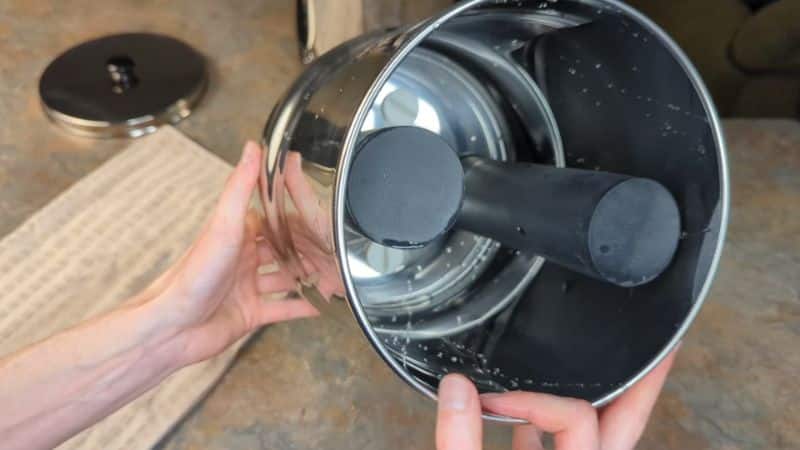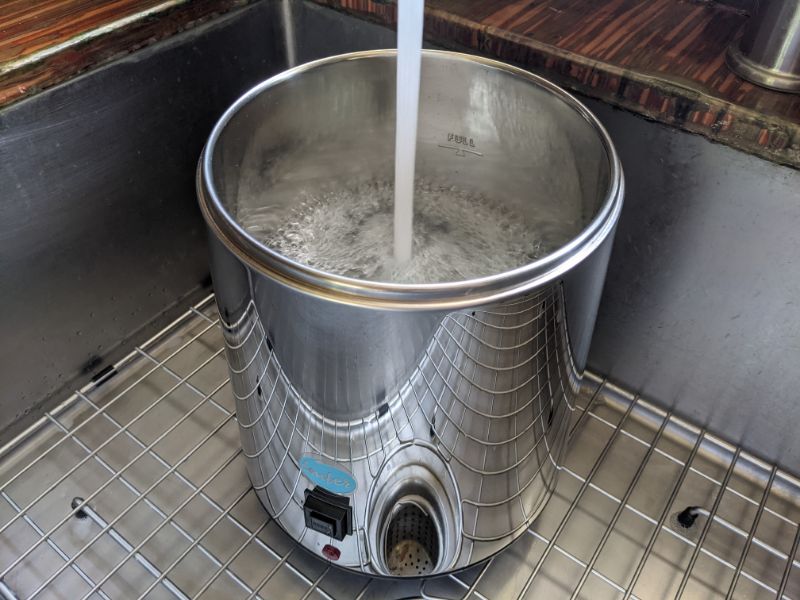Trace amounts of pharmaceuticals are found in drinking water supplies up and down the country. While our knowledge of their human health effects is limited, that’s not to say that you want to drink them in your water.
In this article, we’ve shared everything you should know about the best methods of removing pharmaceuticals from water.
📌 Key Takeaways:
- Pharmaceuticals, including over-the-counter medications, prescription drugs, and pharmaceutical byproducts, have been detected in our water supplies for over two decades.
- We’re currently unaware of the possible health effects of exposure to these contaminants in our water over a long period.
- You can remove pharmaceuticals from your water supply with reverse osmosis, water distillation, nanofiltration, and activated carbon filters.
Table of Contents
- 💡 What Are Pharmaceuticals?
- ❓ Are Pharmaceuticals in Water Harmful?
- 🤔 How Do Pharmaceuticals Get Into Drinking Water?
- 📑 Possible Health Effects of Pharmaceuticals
- ✅ How to Remove Pharmaceuticals from Tap Water
- 💯 What’s the Best Way to Remove Pharmaceuticals from Water?
- 🔎 How To Know if a Water Filter System Can Reduce Pharmaceuticals
- 📑 Final Word
- ❔ FAQ
💡 What Are Pharmaceuticals?
Pharmaceuticals are pharmaceutical compounds, including prescription drugs, over-the-counter medications, and personal care products, which contaminate various water sources such as rivers, lakes, and groundwater. They’re found in tap water supplies, as well as bottled water products that come from a municipal source.
While pharmaceuticals are, of course, helpful and even life-saving to the people they’re intended for, certain drugs may have dangerous side effects when ingested by their unintended audience.

❓ Are Pharmaceuticals in Water Harmful?
We know that pharmaceuticals in water are considered harmful to aquatic life, but based on research so far, the trace levels of these drugs and medications present in drinking water supplies are unlikely to have harmful health effects.
With that said, there are some drugs that are a cause for concern in drinking water regardless of their concentration. For instance, hormone-altering drugs, like birth control medications and contraceptive pills, are possibly dangerous even in low concentrations because hormones can alter the human body even in low levels.
🤔 How Do Pharmaceuticals Get Into Drinking Water?
There are a few ways that pharmaceuticals can get into drinking water, including:
- Human waste – When people take medications, their bodies metabolize the active compounds, and some of these compounds are excreted in urine and feces (where the water cycle begins). Wastewater from homes carries these excreted compounds to sewage treatment plants.
- Wastewater plants – Conventional wastewater treatment plants can remove solid materials and pathogens from sewage, but they’re not equipped to effectively remove all pharmaceutical compounds and other chemicals. Some pharmaceuticals can pass through the treatment process, and are still present in treated wastewater.
- Healthcare facilities – Hospitals, clinics, and other healthcare facilities may be guilty of improper disposal practices or inadequate disposal of unused medications, resulting in the release of pharmaceutical compounds into the environment. These facilities may dispose of unused or expired medications in ways that allow them to enter water systems.
- Agricultural runoff – You might not think it, but pharmaceuticals are used in agriculture. Steroids and antibiotics are often given to livestock, and these can end up in water bodies through runoff from fields and animal waste.
- Other sources of contamination – There are other ways that pharmaceuticals might contaminate healthy water, including through illicit drug use, human activity (swimming, bathing, shaving), veterinary disposal, and landfills (although most modern landfills have lining that prevents leaching into surrounding soils).

📑 Possible Health Effects of Pharmaceuticals
As we mentioned earlier, there’s a lot we still don’t know about the possible health effects of pharmaceuticals and pharmaceutical byproducts in our drinking water supplies.
At low levels, many pharmaceuticals aren’t thought to have health effects on humans. Thankfully, these contaminants aren’t usually present at higher concentrations in drinking water.
However, other pharmaceuticals, especially those that have hormone-disruptive abilities, may be harmful even in trace amounts.
Ultimately, it’s difficult to comment on the possible health effects of pharmaceuticals because there’s still so much that we don’t know on the subject. More conclusive data from laboratory tests is needed to help us understand exactly what long-term exposure to pharmaceuticals might do to the human body.
✅ How to Remove Pharmaceuticals from Tap Water
Below, we’ve outlined the 4 best methods to remove pharmaceuticals from your drinking water.
Activated Carbon
Multi-stage activated carbon filtration can remove 90-98% of pharmaceuticals from tap water.
Activated carbon filters adsorb contaminants onto their media. These contaminants are unable to flow through the filter’s tiny holes, called pores, with the water molecules.
Because activated carbon is cheap and effective, it’s used in a variety of water filter systems, including water filter pitchers, under-sink systems, countertop filters, and whole-house filters. Activated carbon is also a filter stage in reverse osmosis systems.
Alongside pharmaceuticals, activated carbon water filters can also reduce chlorine taste and odor, and chemicals like pesticides and volatile organic compounds (VOCs).
The quality and filtration capacity of an activated carbon filter determines its ability to reduce pharmaceutical concentrations in water. Our advice is to look for a filter that has third-party test data to support the manufacturer’s pharmaceutical reduction claims.

Reverse Osmosis
Reverse osmosis has been proven to remove at least 85% of pharmaceuticals – often up to 99.99% of these impurities.
This water treatment process sends water through several filtration stages (including sediment and carbon water filters) before forcing it through a semi-permeable membrane, with tiny pores that reject the majority of dissolved solids. These rejected contaminants are then flushed away with a small amount of wastewater.
You can find reverse osmosis filter systems for under-sink installation, as well as countertop systems and whole-house systems. See our favorite RO systems here.
The obvious benefit of a reverse osmosis water filtration system is that it doesn’t only greatly reduce pharmaceuticals from a water supply – it also addresses the majority of other TDS, including heavy metals, chemicals, fluoride, arsenic, and suspended solids like bacteria.
However, RO is expensive and produces wastewater, so it might not suit your preferences.
Ultrafiltration
A similar process to reverse osmosis is ultrafiltration, which can also remove an average of 50% or more of pharmaceuticals.
Ultrafiltration membranes have slightly larger pores than RO membranes (0.1-0.01 microns vs 0.0001 microns), but they still provide thorough enough filtration to reduce contaminants of most sizes, including lower levels pharmaceuticals.
Ultrafiltration systems are installed at the cold water line beneath your kitchen sink. The advantage of these systems is that, unlike reverse osmosis, they don’t waste water.
We recommend ultrafiltration to people who want a system with similar contaminant removal abilities to reverse osmosis without the water waste or high expense of this method of water treatment.
Water Distillation
Water distillation is the process of boiling, evaporating, and condensing water, and can reduce up to 99.5% of all impurities, including pharmaceutical drugs.
This water treatment method takes place inside a water distiller – a countertop unit that produces 1-2-gallon batches of purified water at a time.
The process of distillation begins when you add water to the boiling chamber. This water is heated up until it evaporates, where it travels down a cooling corridor and condenses into a separate container. Most impurities, including pharmaceuticals, don’t have the same boiling point as water, so they’re left behind in the boiling chamber.
Water distillation is one of the most effective ways to remove everything from your water, and, unlike a water filtration system, it doesn’t have filters that need to be replaced regularly. However, the setback of this treatment method is that it takes a very long time to purify water (around 5 hours per 1-gallon batch).

💯 What’s the Best Way to Remove Pharmaceuticals from Water?
The best way to remove pharmaceuticals from water depends on your budget, whether or not you want to remove other contaminants as well, and your personal circumstances.
In our opinion, reverse osmosis filter systems are the most appealing for this purpose because of their broad, impressive contaminant removal abilities. However, you might personally not want the expense and maintenance hassle of owning one of these systems.
The best budget method of removing pharmaceuticals from your water supply is a carbon-based water filter pitcher. Make sure to check the filter’s test data to ensure it can reduce these contaminants before you spend your money.
🔎 How To Know if a Water Filter System Can Reduce Pharmaceuticals
You can find out whether or not a water filtration system can reduce pharmaceuticals by checking the product listing for this information.
The best-case scenario is that the manufacturer has shared a data sheet that tells you which contaminants the system has been tested to remove, and to what percentage.
The manufacturer might have tested for specific pharmaceuticals or chemicals/byproducts from these contaminants, so you can easily understand the filter’s performance abilities.
If you can’t find this data online, contact customer service and ask for the test results to be emailed to you. You can also ask directly whether the system can remove a specific pharmaceutical that you’re concerned about.
📑 Final Word
Pharmaceuticals are unquestionably not good for us when we don’t need them, and you’re certainly not alone if you want to remove these impurities from your drinking water.
If you’re concerned about pharmaceuticals in your drinking water, test your water to see what it contains, then look for a suitable treatment system that can remove them.
❔ FAQ
Can you filter pharmaceuticals out of water?
Yes, you can filter pharmaceuticals out of water. The best option for removing pharmaceutical drugs from water is reverse osmosis. You can also use ultrafiltration, carbon filters, and water distillation.
What water filters remove medications?
Many types of water filters remove medications, including water filter pitchers, countertop filters, under-sink systems, and whole-house filters. Check the filter’s performance datasheet to see which pharmaceuticals it can remove.
Does PUR filter remove pharmaceuticals?
Yes, PUR faucet filters can reduce up to 99% of pharmaceuticals present in trace amounts in drinking water.
What is the best way to remove estrogen from water?
The best method of removing estrogen (from birth control medication) from water is RO filtration. You can also reduce this contaminant with ultrafiltration, carbon filtration, and water distillation.
How do you filter endocrine disruptors from water?
You can filter endocrine disrupters from water with a solid carbon block filter, an RO system, an ultrafiltration system, or a water distiller unit.
